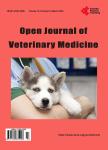Effect of a Wildlife-Livestock Interface on the Prevalence of Intra-Erythrocytic Hemoparasites in Cattle
Effect of a Wildlife-Livestock Interface on the Prevalence of Intra-Erythrocytic Hemoparasites in Cattle作者机构:Department of Wildlife and Animal Resources Management Faculty of Veterinary Medicine Makerere University Kampala Uganda Graduate Studies Program St. George’s University St. George’s Grenada Graduate Studies Program St. George’s University St. George’s Grenada chool of Medicine St. George’s University St. George’s Grenada Pathobiology Academic Program St. George’s Grenada School of Veterinary Medicine St. George’s University St. George’s Grenada Pathobiology Academic Program St. George’s Grenada School of Veterinary Medicine St. George’s University St. George’s Grenada Graduate Studies Program St. George’s University St. George’s Grenada Uganda Wildlife Authority (UWA) Kampala Uganda
出 版 物:《Open Journal of Veterinary Medicine》 (兽医学(英文))
年 卷 期:2013年第3卷第8期
页 面:315-318页
学科分类:1002[医学-临床医学] 100214[医学-肿瘤学] 10[医学]
主 题:Wildlife-Livestock Interface Geographical Information System Proximity Ankole Long-Horned Cattle Intra-Erythrocytic Hemoparasites
摘 要:We conducted a cross-sectional study to establish the effect of proximity of livestock to a wildlife-livestock interface on the relative abundance of intra-erythrocytic hemoparasites in cattle. Blood samples were obtained from 131 randomlyselected cattle raised around Queen Elizabeth National Park. Cattle-farm location was determined by using Global Positioning System device from an arbitrarily reference point. Giemsa-stained blood smears were examined microscopically for intra-erythrocytic hemoparasites. Correlational analysis was used to examine the relationship between farm location and prevalence, whereas risk ratios were used to determine the strength of mixed hemoparasitic infections among cattle, using a significant level of α = 0.05. The location of a cattle farm significantly predicted the prevalence of Anaplasma (rs = 0.33, p 0.05) and Theileria (rs = 0.57, p 0.01) but, farm’s proximity to QENP did not explain the variation in the prevalence of Babesia (rs = 0.14, p 0.2). Although mixed infections occurred in 15% of sampled cattle, concurrent infection of cattle with A. marginale and B. bigemina [RR = 36;95% CI (7.191);p which was recorded. This study demonstrated that unlike the prevalence of B. bigemina, the prevalence of T. parva and A. marginale in livestock significantly increased with close proximity to a wildlife-livestock interface.



